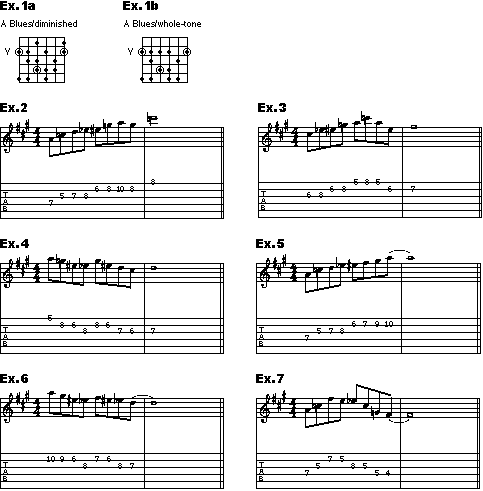To personalize your blues lines, lace
them with notes found outside the
standard blues scale. Here are two
cool ways to do this:
When. The fourth measure of a
12-bar blues is a perfect spot for
adding tension. Here you can play
tensions against the I7 and then
resolve to a IV7 chord tone in bar 5.
What. Two tension-rich hybrid scales
you can use to colorize bar 4 are the
blues diminished and blues
whole-tone. (A hybrid scale combines two scales to make a
new one.) Both the blues diminished and blues whole-tone
begin with the first four notes of a standard blues scale: 1, 3,
4, and 5. In the key of A, that's A, C, D, and E.
The upper degrees of the blues diminished scale are 5, 6,
and 7. In A, that's E, F, and G. The upper degrees of the
blues whole-tone scale are 5 and 7, or E and G in the key of A.
Where. Try the two-octave A blues diminished pattern in Ex.
1a, then compare that to the A blues whole-tone pattern in Ex.
1b. Once you've got the patterns at your fingertips and the
sound of each scale in your ears, it's time to extract lines.
How. The trick is to target a IV7 chord tone before you hit bar
5. This way, you have a destination to work toward -- light at
the end of the tunnel. In our progression, the IV7 is D7, so your
target choices are D, F, A, and C.
Important: When working through the blues diminished scale,
don't hang out on the 7, as it's not a I7 chord tone. Instead, use
the 7 as an approach note to the I7 chord root. For instance,
A7 is spelled A, C, E, G -- 1, 3, 5, 7. While G (7) will clash
with G (7), it makes a strong half-step approach to A, the root.
Loosen your fingers and ears with the next six examples.
Simply plug these licks into bars 4 and 5 of an A 12-bar blues
progression. Examples 2, 3, and 4 are blues whole-tone
For maximum vibe, play with a swing feel.
